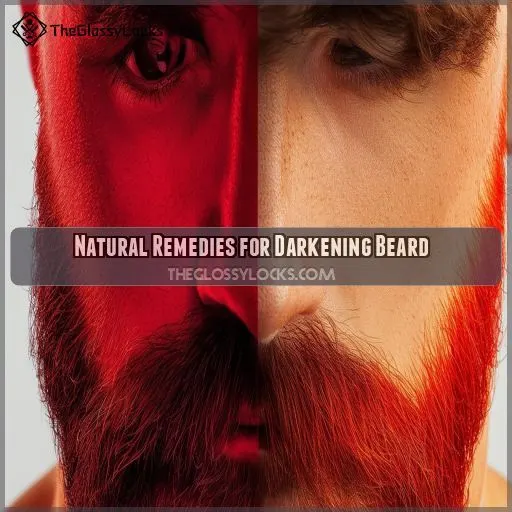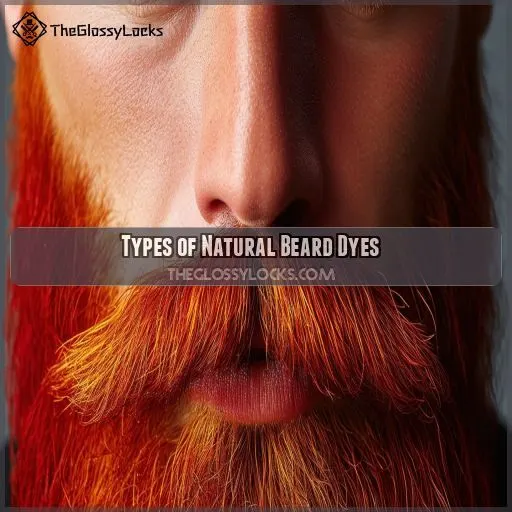This site is supported by our readers. We may earn a commission, at no cost to you, if you purchase through links.

This phenomenon is due to genes, but natural dyes like henna, indigo, and coffee can give your beard a darker shade.
In this article, we’ll explore the science behind your red beard and provide a step-by-step guide to dyeing it black using natural remedies.
Table Of Contents
- Key Takeaways
- How to Turn Red Beard to Black Naturally?
- Genetic Influence on Hair Color
- Understanding Red Beard Phenomenon
- Natural Remedies for Darkening Beard
- Benefits of Using Natural Dyes
- Types of Natural Beard Dyes
- How to Apply Natural Beard Dye
- Considerations Before Dyeing Your Beard
- Benefits of Orange Red Henna Beard Dye
- Application Process for Orange Red Henna Dye
- Maintaining Dark Beard Color
- Frequently Asked Questions (FAQs)
- How to turn a red beard into black?
- How to make a beard naturally black?
- How to get rid of red in beard?
- How can I naturally darken my beard?
- Can I go from a red beard to black naturally?
- How long does it take to dye a beard black?
- Are there natural dyes that wont irritate my skin?
- What foods promote beard growth?
- How often should I wash my beard?
- Conclusion
Key Takeaways
- Red beards are the result of genetics, with certain genes influencing the production of melanin and resulting in higher levels of pheomelanin, which gives hair a red or yellow tone.
- Natural dyes like henna, indigo, black walnut, and cocoa paste can be used to temporarily darken a red beard without the use of harsh chemicals, offering a skin-friendly and eco-conscious option.
- It’s important to do a patch test before applying any dye to your beard to ensure you don’t have an allergic reaction, and to protect your skin with a barrier cream or petroleum jelly.
- Maintaining a dark beard color requires a solid routine, including avoiding frequent washing, using color-safe products, and touching up roots as they grow out.
How to Turn Red Beard to Black Naturally?
Let’s face it, having a red beard can be a bit of a challenge, especially if you’re not a fan of the color.
Maybe you’re tired of the constant attention, or maybe you just want to try out a new look. Whatever the reason, you’re not alone in wanting to turn your red beard black naturally.
So, can you actually turn your red beard black without using harsh chemicals or dyes?
The short answer is yes, but it’s not going to be easy, and it’s not going to happen overnight.
Here are some natural remedies you can try to gradually darken your red beard**.
One popular method is to use coffee as a natural dye.
Simply brew a cup of strong coffee, let it cool, and then use it as a rinse after you wash your beard.
Repeat this process a few times a week, and you may start to notice your beard darkening over time.
Another method is to use indigo powder, which is a natural dye that’s been used for centuries.
Mix the indigo powder with warm water to create a paste, and then apply it to your beard.
Leave the paste on for about an hour before rinsing it out, and repeat the process a few times a week.
You can also try using a combination of coconut oil and lemon juice to darken your beard.
Simply mix equal parts coconut oil and lemon juice, and apply the mixture to your beard.
Leave it on for about an hour before washing it out, and repeat the process a few times a week.
However, they’re a great option if you’re looking for a more natural, gentle way to darken your red beard.
Genetic Influence on Hair Color
The color of your hair is determined by the interplay of genetics and biochemistry, revolving around the production of melanin. Melanin has two primary forms: eumelanin, which provides a dark color (black or brown), and pheomelanin, which gives a lighter color (red or yellow).
Genes like the MC1R gene, inherited from your parents, influence your natural hair color. Certain genetic variations are most common in people with red hair, fair skin, freckles, and increased sensitivity to sun exposure. These MC1R polymorphisms reduce the ability of the melanocortin 1 receptor to stimulate eumelanin production, resulting in higher levels of pheomelanin.
While MC1R is a key gene in normal human pigmentation, other genes also contribute to hair and skin coloring. For example, the ASIP gene can influence red hair, and the KITLG gene further reduces eumelanin levels, affecting blond hair color.
Understanding Red Beard Phenomenon
Red hair is a unique trait, with around 1-2% of the world’s population sporting ginger genes. If you’re one of them, you know that your beard color can range from light copper tones to a deep auburn. So, why do some beards turn out red while others remain dark? It’s all about hair pigment and melanin levels.
Your hair’s color comes from two types of melanin: pheomelanin and eumelanin. Pheomelanin produces red and yellow tones, while eumelanin results in brown and black hues. The amount and ratio of these pigments determine your beard color. If you have a higher concentration of pheomelanin, your beard will likely be ginger.
While beard darkening is an option, remember that your natural red beard is a result of your unique genetic makeup. Embrace your copper tones with pride!
Natural Remedies for Darkening Beard
There are natural remedies you can try to darken your beard. The black walnut treatment involves crushing walnuts, boiling them, and then soaking your beard in the mixture. Alternatively, a cocoa paste can be applied to your beard for 15 minutes.
Black Walnut Treatment
Black walnut hulls offer a natural way to dye your beard black.
To use this method, crush 7-8 black walnuts and boil them in water for an hour and a half.
Once the mixture has cooled, soak your beard in it for 5-20 minutes, depending on your desired color depth.
Keep in mind that black walnut can stain your skin, so be cautious during application and consider doing a patch test beforehand to assess the stain risk and dye time.
This natural beard dye helps you achieve your desired beard hair color but also supports beard growth and overall beard health with its nourishing natural ingredients.
Cocoa Paste Method
Cocoa paste is another natural remedy to darken your beard. This method involves creating a paste by mixing cocoa powder with water and applying it to your beard for around 15 minutes. This natural hair dye process is simple, effective, and chemical-free, offering a temporary solution to achieving a darker beard color.
Benefits of Using Natural Dyes
Natural dyes offer a range of benefits for those looking to change their beard colour. They provide a skin-friendly, eco-conscious option that enhances the health of your beard.
Skin-Friendly Coloring Options
If you have sensitive skin, natural dyes offer a gentler alternative to traditional hair coloring products. Here are some benefits of using natural dyes for your beard:
- Skin-friendly: Natural dyes like henna, indigo, and black walnut hulls are free from harsh chemicals, reducing the risk of allergic reactions and irritation.
- Nourishing: Many natural dyes contain ingredients that nourish and condition your beard, promoting healthy growth and a softer texture.
- Color options: Natural dyes offer a range of colors, from subtle shades to vibrant hues, allowing you to find the perfect match for your desired look.
Eco-Conscious Beauty Choice
Natural dyes are the eco-friendly choice for beard coloring. They’re often derived from plants, making them sustainable and environmentally conscious. Natural dyes are a great way to enhance your beard diversity while being kind to the planet. With natural dyes, you can embrace beard growth and care, all while reducing your environmental footprint.
Enhanced Beard Health
In addition to being eco-friendly, Natural beard dyes can also improve your beard’s health. They contain ingredients that nourish and condition your facial hair, promoting healthy growth and a softer texture.
You can further enhance your beard’s health by incorporating vitamins and protein into your diet. Vitamins A, C, and E are essential for hair growth and can be found in leafy greens, citrus fruits, and nuts. Protein, another key nutrient for hair growth, can be obtained from eggs, beans, and lean meats.
Additionally, consider using a beard vitamin spray to give your beard the nutrients it needs to thrive.
Types of Natural Beard Dyes
For natural beard dyes, you have a few options: henna, indigo, and coffee. Each of these dyes offers a unique set of benefits and drawbacks, so it’s important to choose the one that best suits your needs and desired look.
Henna
Henna is a natural dye derived from the henna plant, known for its reddish-brown hues. It’s a great choice for those who want a plant-based, eco-friendly way to color their beards. This dye doesn’t just color, it also conditions and softens facial hair, making your beard healthier overall.
If you’re thinking about using henna to make your red beard a darker shade, you should know that henna hair dyes are different from regular hair coloring products. They don’t have the chemicals that quickly change dark hair colors. So, it’s a good idea to do a patch test before applying henna to your whole beard. This will help you make sure you get the results you want and avoid any unexpected allergic reactions.
Indigo
Indigo, a natural dye derived from the indigo plant, offers a unique way to enhance your beard color. Here are a few things to keep in mind:
- Benefits: Indigo is perfect for creating shades of blue and black, allowing you to achieve a bold and unique beard color.
- Drawbacks: While indigo can be used to create darker shades, it may not be suitable for covering gray or white hair effectively.
- Cost and Availability: Indigo dye is readily available, and its cost can vary depending on the brand and quantity.
- Application: Follow instructions for mixing and processing time. Always perform a patch test and protect your skin with petroleum jelly or cream.
- Maintenance: Natural dyes may require more frequent touch-ups, especially if you want to maintain a darker beard color.
Coffee
Coffee, a natural dye derived from coffee grounds, can be used to create shades of brown and black for your facial hair. Imagine the rich, warm hues of a freshly brewed cup of coffee, now envision that depth of color enhancing your beard.
While there may be a slight aroma of coffee lingering in your beard post-application, the scent is likely to be subtle and may even evoke a pleasant association with your morning brew.
How to Apply Natural Beard Dye
Before you apply natural beard dye, make sure your beard is clean and prepped. Wash it with a mild shampoo and conditioner to get rid of any dirt or oil. Now, you’re ready to apply the dye.
Preparation Steps
Before you start dyeing your beard, make sure you’ve picked the right dye. Go for a natural dye like henna, which is good for your skin because it doesn’t have harsh chemicals. It’s always a good idea to test the color on a small part of your beard first to make sure you get the shade you want.
Now, it’s time to get your beard ready! Wash your beard with a mild shampoo and conditioner to get it clean. Trimming and shaping your beard will also help the dye go on evenly.
Application Process
How to Apply Natural Beard Dye
Now that your henna paste is ready, it’s time to apply it to your beard. Here’s a step-by-step guide on how to do it:
- Using a brush or your fingers, apply the henna paste evenly to your beard, making sure to cover all the hairs.
- Leave the paste on your beard for the recommended time, which is usually around 2-3 hours.
- Rinse your beard thoroughly with water to remove the paste.
- Wait for at least 48 hours before shampooing your beard to maintain the colour.
Aftercare Tips
Aftercare is essential to maintain your new beard color and keep your facial hair healthy. Here are some tips to care for your freshly dyed beard:
- Avoid washing your beard frequently to prevent the color from fading. When you do wash it, focus on cleaning the skin and base of the hair, rather than lathering up your beard.
- Use color-safe, sulfate- and paraben-free shampoo and conditioner to help maintain your beard color.
- Touch up your beard roots as they grow out to keep your desired color consistent.
- Get enough sleep, as it helps rejuvenate testosterone levels, supporting beard growth and maintenance.
Considerations Before Dyeing Your Beard
Before you dye your beard, there are a few things to keep in mind.
First, always do a patch test on your skin to check for any allergic reactions – better safe than sorry.
Second, protect your skin by applying a barrier cream or petroleum jelly around your beard line to prevent staining.
Patch Testing
Before you start dyeing your beard, it’s really important to do a patch test to make sure your skin is okay with it and you don’t have any bad reactions. Here’s a simple four-step process to guide you:
- Choose a small, hidden spot on your skin, like behind your ear or the inside of your elbow.
- Put a tiny bit of the dye on that spot and leave it alone for a whole day.
- Keep an eye on the test area to see if there’s any redness, irritation, or discomfort during that time.
- If nothing bad happens within 24 hours, you can go ahead and dye your beard, knowing your skin is good with the dye.
Skin Protection
Protecting your skin is important before you start Dyeing your beard. Apply a thin layer of Vaseline or a barrier cream around your beard line to create a protective barrier that prevents the dye from staining your skin. This simple step helps keep your dyeing experience tidy and protects your skin from potential irritation.
Color Maintenance
Once you’ve dyed your beard, keeping it looking fresh is really important to maintain your desired color. Avoid frequent washing, and when you do, focus on cleansing the skin and base of the hair rather than lathering your beard. This routine will help preserve the color of your beard, whether it’s dyed or treated with natural remedies.
Benefits of Orange Red Henna Beard Dye
Orange red henna beard dye offers a range of benefits, from its natural ingredients and ethical production to its long-lasting results. This dye is a great option for those seeking a natural, vibrant color that conditions and softens facial hair without the use of harsh chemicals.
Natural Ingredients
Orange red henna beard dye is a natural beard dye made from pure henna powder. It provides a bright orange-red color that’s ideal for light-toned hair. This dye is 100% natural and plant-based, gluten-free, and chemical-free. The triple-sifted powder makes for a smooth, clump-free paste.
Ethical Production
You want a beard dye that’s good for you and the planet, right? Orange Red Henna Beard Dye is made with care, from start to finish. Here’s what makes it stand out:
- Ethically Sourced: The henna powder is ethically sourced, meaning fair trade and sustainable practices are a priority.
- Natural Ingredients: This dye is 100% natural and plant-based, gluten-free, and free from harsh chemicals.
- Smooth Application: The triple-sifted powder ensures a smooth, clump-free paste, making it easy to apply.
- Eco-Friendly: As a plant-based product, it’s an eco-conscious choice, reducing your environmental footprint.
Long-Lasting Results
Orange red henna beard dye offers long-lasting color results, reducing the frequency of dyeing sessions. This means less time and effort spent on maintaining your desired beard color. The table below illustrates the benefits of using orange red henna beard dye for long-lasting results:
| Benefits | Long-Lasting Results |
|---|---|
| Reduced Dye Frequency | Less time and effort spent on maintaining beard color |
| Beard Care | Focus on skin and hair health, reducing washing frequency |
| Color Maintenance | Easy to touch up roots as they grow out |
| Overall Convenience | Saves time and provides peace of mind |
Application Process for Orange Red Henna Dye
To achieve the best results with orange red henna beard dye, follow these steps:
- Prepare a thick paste by mixing the henna powder with water.
- Apply this paste generously to your beard and mustache, ensuring full coverage.
- Allow the henna to process for a minimum of 2-3 hours. The longer you leave it on, the more intense the color will be.
- Rinse your beard thoroughly with water to remove all traces of the henna paste.
- After 48 hours, use a color-safe, sulfate & paraben-free shampoo to wash your beard and enhance the color.
- Repeat this process whenever you need to refresh the color.
Maintaining Dark Beard Color
Now that you’ve achieved the desired dark beard color, it’s important to maintain it with a solid routine. Beard dye, especially natural dyes, can fade over time, so here’s how to keep your new look lasting longer:
- Avoid frequent washing: This is key to preventing premature fading. When you do wash your beard, focus on cleansing the skin and base of the hair rather than lathering up your entire beard.
- Use color-safe products: Opt for shampoos and conditioners designed for colored hair. These products are formulated to protect and prolong the life of your dye job.
- Refresh the color: Depending on the rate of your beard growth, you may need to touch up your roots every week or so. Keep some dye on hand for quick fixes.
- Protect your skin: When applying dye, always use a barrier cream or petroleum jelly around your beard line. This prevents staining and keeps your skin healthy.
- Maintain a healthy beard: A well-maintained beard is key to color longevity. Condition your beard regularly and consider using natural oils like argan or jojoba to keep it soft and shiny.
Frequently Asked Questions (FAQs)
How to turn a red beard into black?
You might be hesitant to try new methods to change your beard color, but there are a few natural options to explore. Try black walnuts, a natural dye, or opt for henna or cocoa paste.
How to make a beard naturally black?
You can use natural remedies like sesame seeds, lemon juice and vinegar, onion juice, or earth dug from outside mixed with water. Alternatively, try a sage water treatment, or use mustard oil and castor oil.
How to get rid of red in beard?
Dyeing your beard is the best way to get rid of the red. Choose a dye close to your natural colour. Natural methods exist, but they’re short-term solutions.
How can I naturally darken my beard?
For a darker, fuller beard, try a darkening beard wash or leave-in balm. Or, for a natural approach, apply henna, crushed black walnuts, or cocoa powder.
Can I go from a red beard to black naturally?
Yes, you can use natural beard dyes like henna, black walnuts, or cocoa paste. You can also try beard-darkening oils. Always do a patch test first to check for allergies.
How long does it take to dye a beard black?
It depends on the product you use. For some dyes, it takes 5 to 10 minutes, while others require 20 to 40 minutes, or even longer.
Are there natural dyes that wont irritate my skin?
Natural beard dyes are available that are formulated to be gentle on the skin and reduce the possibility of irritation. Examples include Refectocil Non-Irritating Beard Dye, Grizzly Mountain Organic & Natural Dark Brown Beard Dye, and Herb For Men’s PPD & Ammonia-Free Mustache & Beard Dye.
What foods promote beard growth?
A diet rich in vitamins and protein promotes beard growth. Try poultry, fish, nuts, eggs, and leafy greens. Potatoes can help too, especially for men with patchy beards.
How often should I wash my beard?
Most sources recommend washing your beard 2-3 times per week. However, some people suggest washing it every 3-5 days, or even once a week. It depends on your beard type, skin sensitivity, and environment.
Conclusion
If you’re looking to switch up your fiery red beard for a shadowy black mane, natural remedies like henna, indigo, and coffee offer a safe and eco-friendly solution.
We’ve explored the genetics of your rare red whiskers and offered a step-by-step guide to dyeing it black, using nature’s palette.
Now, with this knowledge, you can embrace a darker shade while nourishing your beard and respecting the environment.













